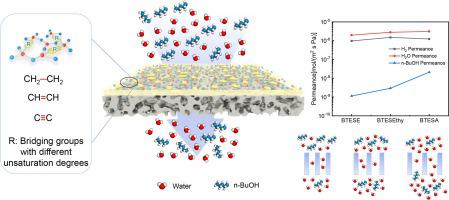当前位置:
X-MOL 学术
›
Sep. Purif. Technol.
›
论文详情
Our official English website, www.x-mol.net, welcomes your feedback! (Note: you will need to create a separate account there.)
Network engineering of organosilica membranes for efficient pervaporation dehydration
Separation and Purification Technology ( IF 8.6 ) Pub Date : 2024-03-21 , DOI: 10.1016/j.seppur.2024.127105 Linglin Cheng , Meng Guo , Jing Zhong , Xiuxiu Ren , Rong Xu , Gang Li , Yanzhu Ji , Minghui Qiu , Masakoto Kanezashi
Separation and Purification Technology ( IF 8.6 ) Pub Date : 2024-03-21 , DOI: 10.1016/j.seppur.2024.127105 Linglin Cheng , Meng Guo , Jing Zhong , Xiuxiu Ren , Rong Xu , Gang Li , Yanzhu Ji , Minghui Qiu , Masakoto Kanezashi

|
In the petroleum industry, the mixing of ethanol (EtOH), isopropanol (IPA), and n-butanol (n-BuOH) with water is a prevalent occurrence in both production and recovery phases. Obtaining the required degree of purity via dehydration poses a significant challenge that needs to be addressed. Pervaporation has emerged as a promising method for separating azeotropic mixtures due to its energy efficiency and independence from vapor-liquid equilibrium constraints. In this study, organosilica precursors, namely 1,2-bis(triethoxysilyl)ethane (BTESE), 1,2-bis(triethoxysilyl)ethylene (BTESEthy), and 1,2-bis(triethoxysilyl)acetylene (BTESA), were utilized for the fabrication of organosilica membranes using the sol–gel method. Subsequently, these membranes were employed for pervaporation dehydration of EtOH, IPA, and n-BuOH. This study investigates the effect of the degree of unsaturation of the bridged group, feed composition, and C atom count of alcohol on membrane dehydration performance. The membranes demonstrated superior separation performance for the n-butanol/water mixtures compared to other alcohol/water systems investigated. In this particular context, BTESE membrane exhibited a significant separation factor, although accompanied by a reduced permeation flux. Conversely, BTESA membrane demonstrated a decreased separation factor but an increased permeation flux. The comparison between gas permeation and pervaporation highlighted that the separation mechanism was primarily governed by molecular sieving through the organosilica membranes.
中文翻译:

高效渗透汽化脱水有机硅膜网络工程
在石油工业中,乙醇 (EtOH)、异丙醇 (IPA) 和正丁醇 (n-BuOH) 与水的混合在生产和回收阶段都很常见。通过脱水获得所需的纯度是一个需要解决的重大挑战。由于其能源效率和不受气液平衡约束的影响,渗透蒸发已成为一种有前景的分离共沸混合物的方法。在这项研究中,使用了有机二氧化硅前体,即 1,2-双(三乙氧基甲硅烷基)乙烷(BTESE)、1,2-双(三乙氧基甲硅烷基)乙烯(BTESEthy)和 1,2-双(三乙氧基甲硅烷基)乙炔(BTESA)使用溶胶-凝胶法制备有机硅膜。随后,这些膜用于 EtOH、IPA 和 n-BuOH 的渗透蒸发脱水。本研究研究了桥连基团的不饱和度、进料组成和醇的碳原子数对膜脱水性能的影响。与所研究的其他醇/水系统相比,该膜对正丁醇/水混合物表现出优异的分离性能。在这种特殊情况下,BTESE 膜表现出显着的分离因子,但伴随着渗透通量的降低。相反,BTESA 膜表现出分离因子降低但渗透通量增加。气体渗透和渗透蒸发之间的比较强调,分离机制主要由通过有机硅膜的分子筛分控制。
更新日期:2024-03-21
中文翻译:

高效渗透汽化脱水有机硅膜网络工程
在石油工业中,乙醇 (EtOH)、异丙醇 (IPA) 和正丁醇 (n-BuOH) 与水的混合在生产和回收阶段都很常见。通过脱水获得所需的纯度是一个需要解决的重大挑战。由于其能源效率和不受气液平衡约束的影响,渗透蒸发已成为一种有前景的分离共沸混合物的方法。在这项研究中,使用了有机二氧化硅前体,即 1,2-双(三乙氧基甲硅烷基)乙烷(BTESE)、1,2-双(三乙氧基甲硅烷基)乙烯(BTESEthy)和 1,2-双(三乙氧基甲硅烷基)乙炔(BTESA)使用溶胶-凝胶法制备有机硅膜。随后,这些膜用于 EtOH、IPA 和 n-BuOH 的渗透蒸发脱水。本研究研究了桥连基团的不饱和度、进料组成和醇的碳原子数对膜脱水性能的影响。与所研究的其他醇/水系统相比,该膜对正丁醇/水混合物表现出优异的分离性能。在这种特殊情况下,BTESE 膜表现出显着的分离因子,但伴随着渗透通量的降低。相反,BTESA 膜表现出分离因子降低但渗透通量增加。气体渗透和渗透蒸发之间的比较强调,分离机制主要由通过有机硅膜的分子筛分控制。



























 京公网安备 11010802027423号
京公网安备 11010802027423号